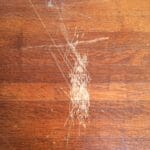Imagine sitting in your living room, enjoying a quiet evening, when you suddenly notice a wet spot forming on your ceiling. Your heart skips a beat.
Could this simple, seemingly harmless leak turn into a disaster? The thought of a ceiling collapsing is terrifying, isn’t it? You’re not alone in wondering about the dangers a leaking ceiling might pose. Many homeowners face this unsettling issue and worry about the potential consequences.
We’ll unravel the mystery behind leaking ceilings and their potential to collapse, giving you the knowledge and peace of mind you need. Your home is your sanctuary, and understanding the risks associated with water damage can help you protect it. Keep reading to discover what steps you can take to ensure your safety and prevent a catastrophe.

Credit: www.greenstarservices.co.uk
Causes Of Ceiling Leaks
Ceiling leaks can be a homeowner’s nightmare, causing not only inconvenience but also potential structural damage. Understanding the causes of these leaks is crucial for prevention and timely action. Whether it’s the aftermath of a storm, plumbing gone awry, or structural issues, pinpointing the source can save you from bigger problems down the road.
Weather-related Damage
Weather can wreak havoc on your home, especially during intense storms or heavy rainfall. Imagine waking up to a thunderstorm that tears off a portion of your roof, leading to water seeping through your ceiling. Have you checked your roof’s condition lately? Regular inspections and maintenance can help prevent weather-related leaks.
Plumbing Issues
Plumbing can be a hidden source of ceiling leaks. Picture this: a pipe bursts in your bathroom and water begins to pool above your ceiling. Do you know where your main shut-off valve is? Promptly addressing plumbing issues can prevent water from damaging your ceiling and potentially causing it to collapse.
Structural Problems
Structural integrity is essential for your home’s safety. A sagging ceiling could indicate underlying structural issues. Have you noticed any unusual cracks or bulges? These could be warning signs of a compromised structure that needs immediate attention to avoid a catastrophic collapse.
Whether you’re dealing with unpredictable weather, faulty plumbing, or structural deficiencies, taking action before these issues escalate can prevent your ceiling from becoming a hazard. Could a ceiling collapse be lurking in your home? It might be time to investigate further and ensure your sanctuary remains safe and sound.
Warning Signs Of Ceiling Collapse
A leaking ceiling can be more than a nuisance. It might signal an impending disaster. Understanding the warning signs of a ceiling collapse is crucial. These signs often appear before the ceiling gives way. Early detection can prevent accidents and costly repairs.
Visible Sagging
Notice a dip or droop in your ceiling? This could indicate a severe problem. Sagging suggests structural issues. The weight of water can cause the ceiling to bend. Over time, the ceiling material weakens. This is a clear sign of stress. Act quickly if you see sagging.
Water Stains
Brown or yellow spots on the ceiling can be alarming. Water stains indicate leaks from above. These stains can spread and worsen. They weaken the ceiling material. Moisture leads to mold growth. Mold is harmful to health. Address water stains promptly.
Cracks And Bulges
Cracks in the ceiling are a red flag. They show that the ceiling is under pressure. Bulges are another warning sign. They occur when water gathers behind the ceiling. This buildup can lead to collapse. Cracks and bulges need immediate attention. Regular checks can prevent disasters.
Immediate Actions To Take
Discovering a leaking ceiling can be alarming. It’s crucial to act swiftly. Quick response can prevent further damage and ensure safety. Knowing what to do can make a huge difference.
Evacuate The Area
First, clear the room. A leaking ceiling can collapse without warning. Ensure everyone is safe. Move valuables away from the leak. Safety comes first.
Contact Professionals
Reach out to experts. Call a plumber or a building inspector. They can assess the situation properly. Don’t try to fix it yourself. Professional help is essential.
Document Damage
Take photos of the damage. Record videos if possible. Documenting helps with insurance claims. It provides proof of the extent of damage. Keep a detailed record.

Credit: www.reddit.com
Preventive Measures
A leaking ceiling can lead to serious problems if ignored. Over time, water damage might weaken the ceiling’s structure, risking collapse. To prevent such disasters, taking proactive steps is crucial. Implementing preventive measures can save both money and stress.
Regular Inspections
Schedule regular inspections of your ceiling. This helps catch leaks early. Look for signs like water stains or discoloration. Check areas around light fixtures and corners. Use a flashlight to spot hidden issues. Regular checks keep your home safe.
Routine Maintenance
Perform routine maintenance tasks to protect your ceiling. Clean gutters to prevent water overflow. Ensure downspouts direct water away from your home. Trim trees to avoid branch damage. Fix small leaks immediately to prevent bigger problems.
Upgrading Materials
Consider upgrading materials for better durability. Use waterproof paints and sealants. Opt for mold-resistant drywall in vulnerable areas. Choose high-quality insulation to prevent moisture buildup. Investing in better materials can extend your ceiling’s lifespan.
Long-term Solutions
Addressing a leaking ceiling requires more than just temporary fixes. Long-term solutions ensure the safety and integrity of your home. They prevent potential ceiling collapses and costly damages. Explore comprehensive strategies to tackle the root causes of leaks.
Roof Repair Or Replacement
Fixing or replacing the roof is essential. A damaged roof often leads to leaks. Inspect for missing shingles or cracked tiles. Regular maintenance extends the roof’s life. If the damage is extensive, consider a full roof replacement. It might be more cost-effective in the long run. A well-maintained roof protects your home from water damage.
Improving Drainage Systems
Proper drainage prevents water accumulation on the roof. Clean gutters ensure rainwater flows away from the structure. Install downspouts to channel water away from the foundation. Check for blockages regularly. A well-functioning drainage system reduces the risk of leaks. It also prevents structural damage to your home.
Enhancing Structural Support
A strong structure can withstand leaks better. Reinforce weak areas of your ceiling. Use materials that resist water damage. Consult with a structural engineer for guidance. Strengthening the ceiling can prevent collapses. This step provides peace of mind during heavy rains.

Credit: www.allcoastroofing.com.au
Understanding Insurance And Liability
Leaking ceilings can lead to unexpected collapses. Water damage weakens structures over time. Understanding insurance and liability is crucial. It helps cover repair costs and any potential damages. Stay informed to protect your home and safety.
Understanding insurance and liability helps protect your home from ceiling leaks. Knowing your coverage and responsibilities is crucial. It ensures you’re prepared for any unexpected issues. Insurance policies can be complex. Grasping the basics can prevent future stress.Homeowner’s Insurance Coverage
Homeowner’s insurance usually covers ceiling leaks. But, it depends on the cause. Sudden events like storms or plumbing failures are often covered. Gradual damage, like long-term leaks, might not be. Always review your policy. Ensure you understand what is included. Some policies might need additional endorsements. These provide extra protection.Liability For Damages
Liability for damages can vary. If your ceiling damages a neighbor’s property, you might be liable. This can include water leaking into adjacent units. Your insurance may cover these costs. It’s important to act quickly. Notify your insurer about any incidents. Document the damage thoroughly. This can help in claims processing. Being proactive can prevent further issues.Frequently Asked Questions
Can A Leaking Ceiling Cause Serious Damage?
Yes, it can. Water weakens structures. Mold grows. Damages increase over time. Immediate repair is crucial.
What Signs Indicate A Ceiling Might Collapse?
Sagging, bubbling, or discoloration. Water drips persistently. Cracks appear. Act quickly to prevent collapse.
How Long Before A Leaking Ceiling Collapses?
Varies greatly. Depends on leak severity and materials. Immediate inspection is necessary. Avoid risks.
Is It Safe To Stay Under A Leaking Ceiling?
No, it’s not safe. Risk of collapse exists. Move belongings. Contact a professional for inspection.
What Should I Do If My Ceiling Leaks?
Catch water with buckets. Move furniture. Turn off electricity. Call a professional immediately for repairs.
Conclusion
A leaking ceiling can lead to serious problems. Ignoring it is risky. Over time, water damage weakens the structure. This increases the chance of a collapse. Regular checks and prompt repairs help prevent disasters. Look for signs like stains or sagging areas.
Early action saves money and ensures safety. Consult a professional for a thorough inspection. Taking care of a leaking ceiling is crucial. Protect your home and loved ones by staying alert. Remember, prevention is always better than repair. Make safety your priority.
Stay informed and act quickly. Your home’s stability depends on it.




